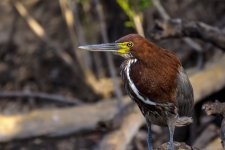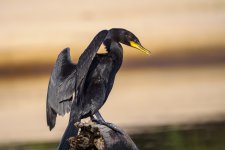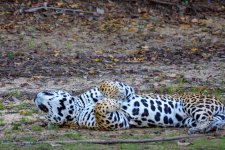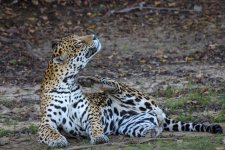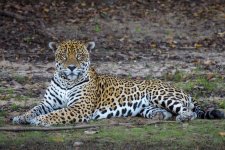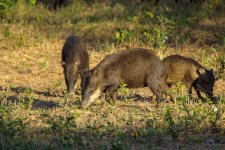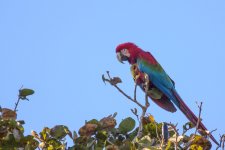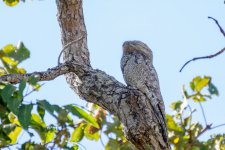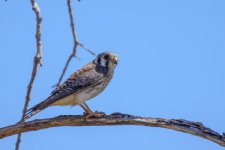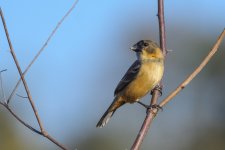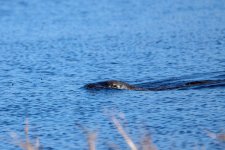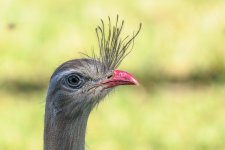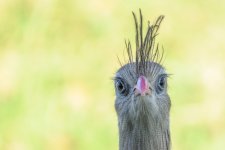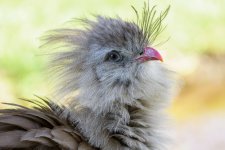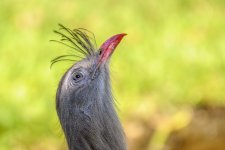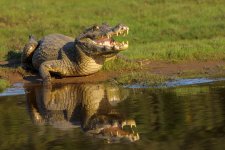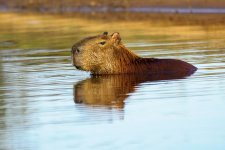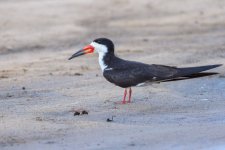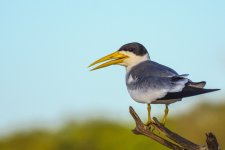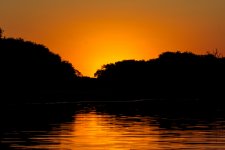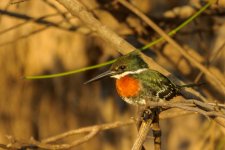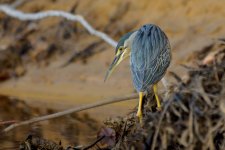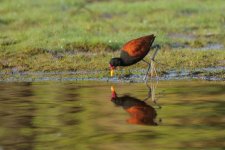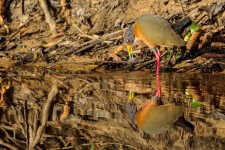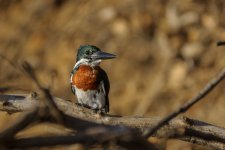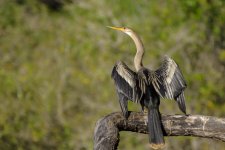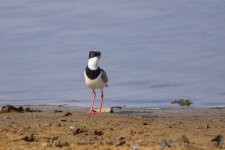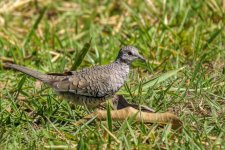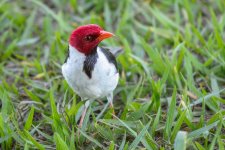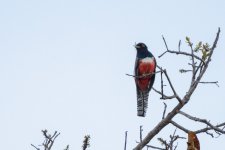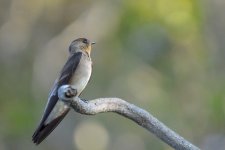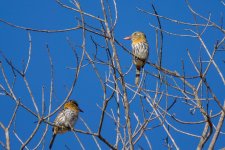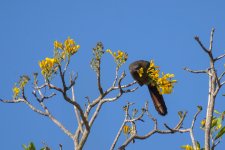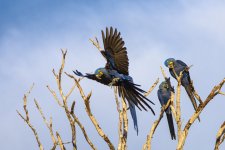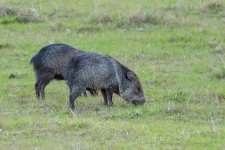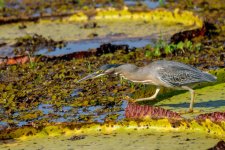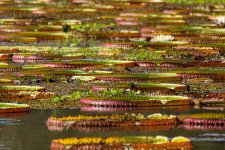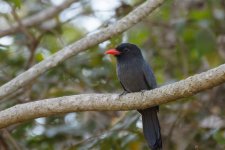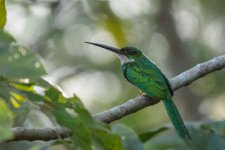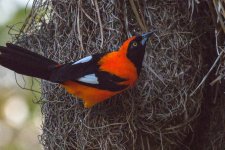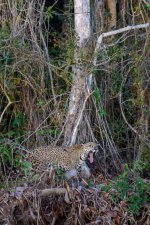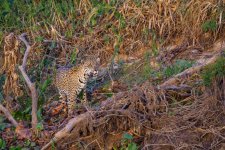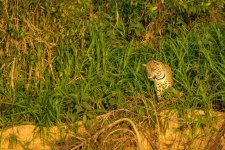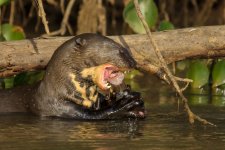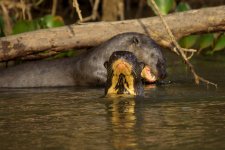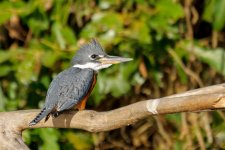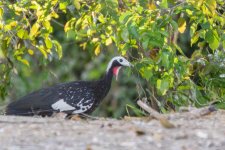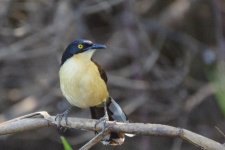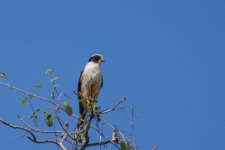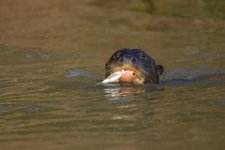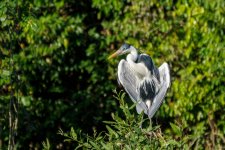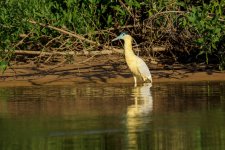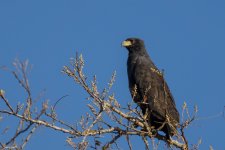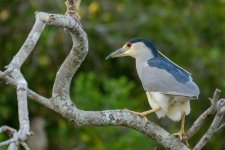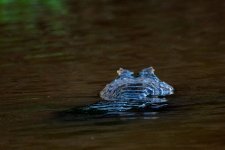kitefarrago
Well-known member
In the afternoon we decided to try something different: Instead of going out in a vehicle we would go out in two small boats. We split into two groups of three, Octavio going with one of the couples going up the Rio Negro and I with the other couple going downriver.
The boats were quite small with outboard motors, and if there was something of interest the drivers could turn off the engine and allow us to glide without noise and vibration. This worked quite well for photography from the boat. I found these outings really enjoyable - it was a much quieter experience than the rather noisy open vehicle with its diesel engine.
This allowed us to get really good views of riverside birds that it would be hard to get close to on foot or with the vehicle. It seems they were quite accustomed to boats and didn't pay them too much attention. We saw a White-winged Swallow on a dead tree, and our kingfisher count increased by adding Amazon and Green to our tally. We got our first close look at a Rufescent Tiger Heron, and were enjoying a photo session with a very confiding Neotropical Cormorant when another boat came up at high speed: Octavio and his boat had found a Jaguar!
All ideas of a quiet float on the river gone, our boat driver got the engine on again with a bit of trouble and we raced in the opposite direction. Good thing we hadn't got very far yet! He knew where the sighting had occurred and as we got close to the bend he slowed down, making sure that our approach wouldn't do anything to alarm the animal if it was still present.
And there it was, lying on the opposite bank: A male Jaguar, estimated by the experts to be around three years old, just lounging without any concern for our boats.
They see the big cats at this fazenda maybe once every couple of months, so this was a very big deal. I know that people go to the Pantanal to see Jaguars, but not to this part of it! Indeed, the cat we had secretly hoped to see here was Puma.
There were just the three boats from the fazenda, and we all kept strictly to the opposite bank from where the cat was. However, the Rio Negro isn't a very broad river so we weren't that distant. Unfortunately from a photographic point of view the Jaguar was in the shade, and by now the sun was low and the light wasn't that good. But I don't think that any of us was thinking about that at the time - we were just drinking in the experience.
The driver of the other boat, Mendoza, had gone into the water, clearly not worried about the piranhas or caimans and was holding on to our two boats so that we could stay stationary without the use of an engine.
Once the cat rose and we wondered what would happen now, but all it did was to turn once and to lie down again. The third boat was a family with a small boy who clearly thought a stationary jaguar wasn't worth looking at for more than a few minutes, and after half an hour or maybe a bit longer they left, after he'd inadvertently made some noises as he was trying to play in the boat. We were relieved by this, and all of us had been puzzled by the `try to take a selfie with jaguar in the background' idea.
Once there were only the two boats Mendoza very slowly started to walk towards the other shore with the two boats in tow, to allow us to get a slightly closer view. All this was done very slowly and carefully, and through all this the cat didn't stir. Eventually he decided we were close enough and the cat just stayed lying there.
As it was getting darker a young man working as a guide at the fazenda came up in a kayak, and he was very happy to have caught the Jaguar. After he'd had a chance to watch the cat it finally seemed to decide that it was time to move, and as the sun was going down the cat got up and returned to the forest.
Two more boats which arrived from the fazenda, having interrupted a drive in the hope os sharing our sighting arrived too late, and all they could do was to return to the lodge with us. We gave the kayaker a tow since he didn't even have a torch with him to get him safely back in the dark.
What an afternoon! We had been hoping to see Jaguars at our next destination, but instead we'd had a totally uncrowded ninety minutes or so with a completely relaxed cat just hanging out. The complementary caipirinhas tasted particularly well that evening!
Rufescent Tiger Heron
Neotropic Cormorant
Jaguar x 3
Andrea
The boats were quite small with outboard motors, and if there was something of interest the drivers could turn off the engine and allow us to glide without noise and vibration. This worked quite well for photography from the boat. I found these outings really enjoyable - it was a much quieter experience than the rather noisy open vehicle with its diesel engine.
This allowed us to get really good views of riverside birds that it would be hard to get close to on foot or with the vehicle. It seems they were quite accustomed to boats and didn't pay them too much attention. We saw a White-winged Swallow on a dead tree, and our kingfisher count increased by adding Amazon and Green to our tally. We got our first close look at a Rufescent Tiger Heron, and were enjoying a photo session with a very confiding Neotropical Cormorant when another boat came up at high speed: Octavio and his boat had found a Jaguar!
All ideas of a quiet float on the river gone, our boat driver got the engine on again with a bit of trouble and we raced in the opposite direction. Good thing we hadn't got very far yet! He knew where the sighting had occurred and as we got close to the bend he slowed down, making sure that our approach wouldn't do anything to alarm the animal if it was still present.
And there it was, lying on the opposite bank: A male Jaguar, estimated by the experts to be around three years old, just lounging without any concern for our boats.
They see the big cats at this fazenda maybe once every couple of months, so this was a very big deal. I know that people go to the Pantanal to see Jaguars, but not to this part of it! Indeed, the cat we had secretly hoped to see here was Puma.
There were just the three boats from the fazenda, and we all kept strictly to the opposite bank from where the cat was. However, the Rio Negro isn't a very broad river so we weren't that distant. Unfortunately from a photographic point of view the Jaguar was in the shade, and by now the sun was low and the light wasn't that good. But I don't think that any of us was thinking about that at the time - we were just drinking in the experience.
The driver of the other boat, Mendoza, had gone into the water, clearly not worried about the piranhas or caimans and was holding on to our two boats so that we could stay stationary without the use of an engine.
Once the cat rose and we wondered what would happen now, but all it did was to turn once and to lie down again. The third boat was a family with a small boy who clearly thought a stationary jaguar wasn't worth looking at for more than a few minutes, and after half an hour or maybe a bit longer they left, after he'd inadvertently made some noises as he was trying to play in the boat. We were relieved by this, and all of us had been puzzled by the `try to take a selfie with jaguar in the background' idea.
Once there were only the two boats Mendoza very slowly started to walk towards the other shore with the two boats in tow, to allow us to get a slightly closer view. All this was done very slowly and carefully, and through all this the cat didn't stir. Eventually he decided we were close enough and the cat just stayed lying there.
As it was getting darker a young man working as a guide at the fazenda came up in a kayak, and he was very happy to have caught the Jaguar. After he'd had a chance to watch the cat it finally seemed to decide that it was time to move, and as the sun was going down the cat got up and returned to the forest.
Two more boats which arrived from the fazenda, having interrupted a drive in the hope os sharing our sighting arrived too late, and all they could do was to return to the lodge with us. We gave the kayaker a tow since he didn't even have a torch with him to get him safely back in the dark.
What an afternoon! We had been hoping to see Jaguars at our next destination, but instead we'd had a totally uncrowded ninety minutes or so with a completely relaxed cat just hanging out. The complementary caipirinhas tasted particularly well that evening!
Rufescent Tiger Heron
Neotropic Cormorant
Jaguar x 3
Andrea
Attachments
Last edited:




